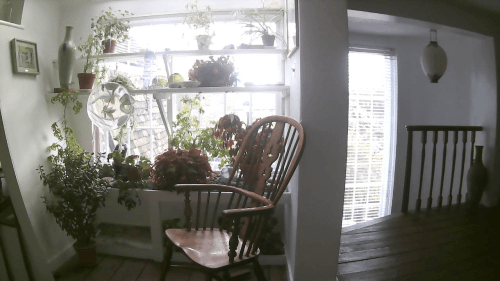
Live feed from Kettle's Yard House: 1 frame every 8 seconds between 5.30am and 8.30pm. The view is from the first floor of the Kettle’s Yard cottages, looking towards Northampton Street. Featured: Gregorio Vardanega's Disc and Spherical Construction, among others.
When Jim and Helen Ede bought Kettle’s Yard in 1957, it consisted of four tumbledown 19th-century cottages, which they set about restoring and altering with the help of a local architect. This space, known as the ‘bridge’, was built to connect the three adjoining cottages with the fourth at first floor level.
On sunny days, the bridge is flooded with light. Jim Ede sought to bring natural light into his home at every opportunity. He installed large windows here, creating a small conservatory for plants to grow amongst the artworks and objects. In the adjacent sitting room he added a spiral staircase, illuminated by a double-height window and a Japanese silk lantern.
Ede was fascinated by the way light and shadows could animate a space as well as the objects and artworks within it. Even when there are no visitors, Kettle’s Yard remains full of life and movement, constantly shifting depending on the time of day, the weather or the changing seasons. It’s a space that rewards slow looking. Chairs, like this rocking chair, invite us to sit and absorb our surroundings. Here, you can watch sunlight dancing off the spherical glass fishing floats, or casting shadows of spiral patterns on the floor beneath the plant shelves. In the afternoon, shafts of light fall onto the tall vessel propped against the banister – an ancient amphora from the Sahara desert.
In this space, Ede also chose artworks that harness and interact with the changing light. Suspended in front of the plants, Gregorio Vardanega’s Perspex Disc rotates and refracts light with every subtle movement of the air. Look even more closely, and you may spot another of Vardanega’s suspended sculptures, Spherical Construction, nestled among the plants in the top right corner. These are accompanied by William Staite Murray’s tall pot, The Heron, and Ben Nicholson’s small still-life, 1944 (mugs) in the top left. At certain times of day you may also see two new glass works by Linder: Circubit (upper shelf) and Alembic (lower shelf to the left). These are part of our exhibition Linderism, currently in our galleries and across Kettle’s Yard which we hope to open again, when we are able.
Plants were another way that Ede brought nature and life indoors, each growing and flowering with the changing seasons. The plants seen today are varieties Jim and Helen Ede grew and loved – lemon-scented pelargoniums, trailing tradescantia and exotic succulents and cacti – many of which descend from cuttings of the original plants.
Jim Ede wrote about this space in his book, ‘A Way of Life’:
“This is an interior which looks into the outer world and has for me a transparent stillness through which to find and hold a sense of peace amidst ‘the manifold changes of this world’; peace which will, I hope, create a touchstone for life itself.”
Credits
Webcam technical support: Tom Noblett and Benedict de Silva. Set up and texts by Helen Dickman and Eliza Spindel. Linder works fabricated with Jochen Holz. Commissioned for Linderism by Kettle’s Yard.
Additional news articles:
The Art Newspaper - Three arty things to do from home this weekend